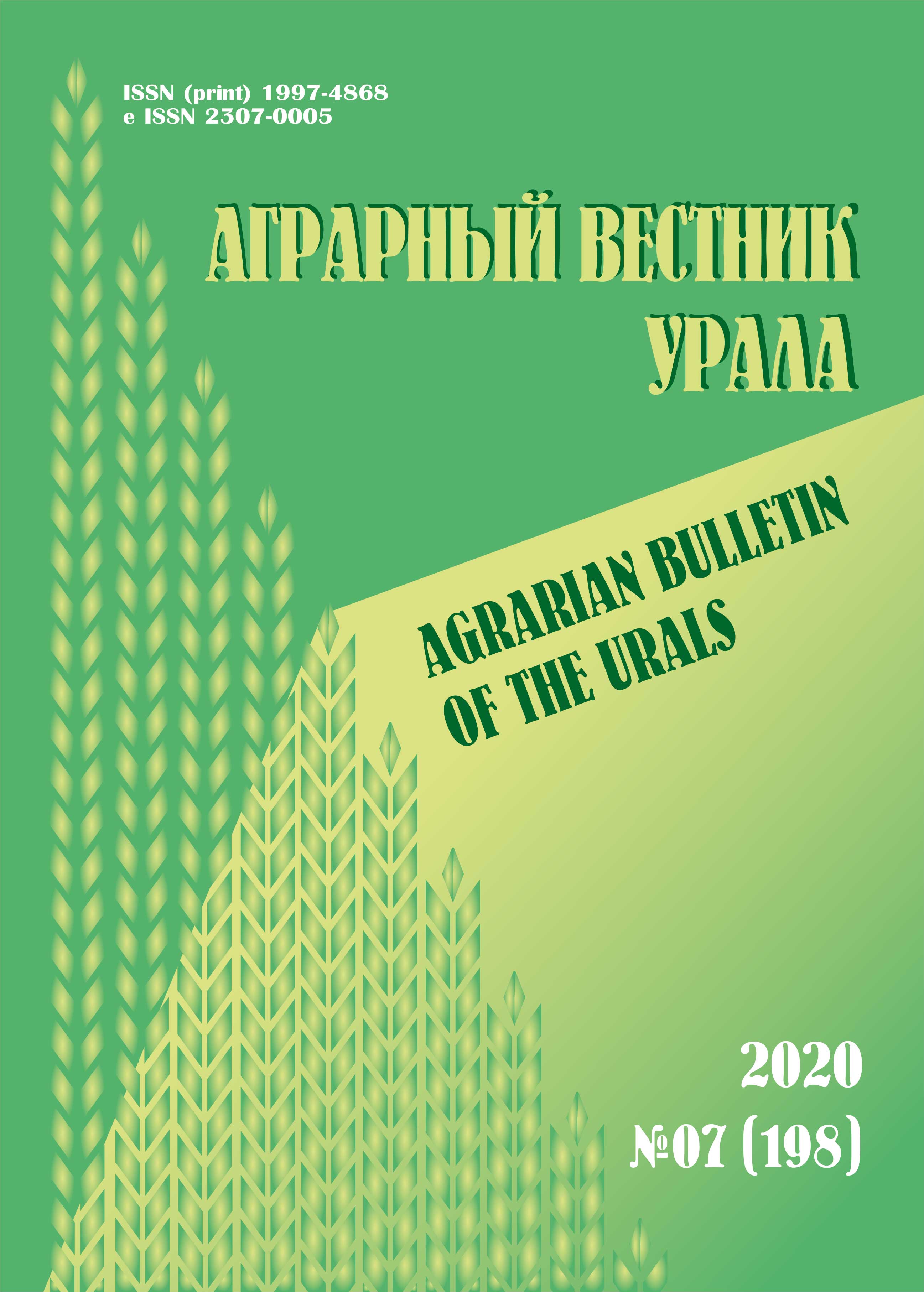Russian Federation
Yekaterinburg, Russian Federation
Abstract. A study of the antibiotic susceptibility of bacteria of the genus Enterobacter, selected at regional dairy enterprises, was carried out. The purpose of this work was to assess the phenotypic resistance profiles of Enterobacter spp. in the loci of fermenal microbiocenoses related to milk production. Research methodology and methods. In the course of the work carried out, milk, mammary gland secretions, and udder washes from cows at dairy cattle breeding enterprises located in different districts of the Ural region were examined. The phenotypic resistance of Enterobacter spp. Isolates was analyzed to 10 antibacterial drugs: ciprofloxacin, enrofloxacin, ofloxacin, meropenem, doxycycline, chloramphenicol, ceftriaxone, amoxicillin, ampicillin, rifampicin. Results. Average sensitivity values of Enterobacter spp. for all surveyed enterprises were at the level of 2.0–3.3 conventional units (at maximum = 4) to target antibiotics, and at the level of 2.0–2.1 conventional units to non-target antibiotics. The highest bactericidal efficacy was found in fluoroquinolones, the lowest in doxycycline and chloramphenicol. For individual enterprises, the average resistance profile included good sensitivity to 3–4 antibiotics, reduced to 4–5 and resistance to 1–2 antibiotics. The main conclusion is that in eight surveyed enterprises, the usual pattern was the resistance of isolates or their low sensitivity to several antibiotics of different classes, which indicates an unfavorable situation with AMR. Scientific novelty. The results obtained in the course of the work performed made it possible to assess the current and actual levels of resistance of Enterobacter spp. Isolates inhabiting those loci of fermenal microbiocenoses that are directly related to milk production.
antimicrobial resistance, antibiotic resistance, enterobacteria, Enterobacter spp., Antibiotics, phenotypic antibiotic sensitivity, resistance profile, animal husbandry, milk
1. Li X., Aly S. S., Su Z., Pereira R. V., Williams D. R., et al. Phenotypic Antimicrobial Resistance Profiles of E. coli and Enterococcus from Dairy Cattle in Different Management Units on a Central California Dairy // Journal of Clinical Microbiology. 2018. Vol. 7. Pp. 311-317. DOI:https://doi.org/10.4172/2327-5073.1000311.
2. Global Framework for Development & Stewardship to Combat Antimicrobial Resistance. Draft Roadmap. WHO/EMP/IAU/2017.08 (revised 19 October 2017) [e-resource]. URL: https://www.who.int/antimicrobial-resistance/global-action-plan/UpdatedRoadmap-Global-Framework-for-Development-Stewardship-to-combatAMR_2017_11_03.pdf?ua=1 (date of reference: 11.07.2021).
3. Rodrigues I. A., Ferrari R. G., Panzenhagen P. H. N., Mano S. B., Conte-Junior C. A. Antimicrobial resistance genes in bacteria from animal-based foods // Advances in Applied Microbiology, eds. G. M. Gadd, S. Sariaslani. 2020. Vol. 112. Pp. 143-183. DOI:https://doi.org/10.1016/bs.aambs.2020.03.001.
4. Hu Y., Yang X., Li J., Lu N., Liu F., Wu J., Lin I. Y., Wu N., Weimer B. C., Gao G. F., Liu Y., Zhu B. The Bacterial Mobile Resistome Transfer Network Connecting the Animal and Human Microbiomes // Applied and Environmental Microbiology. 2016. Vol. 82 (22). Pp. 6672-6681. DOI:https://doi.org/10.1128/AEM.01802-16.
5. Von Wintersdorff C. J. H., Penders J., van Niekerk J. M., Mills N. D., Majumder S., van Alphen L. B., Savelkoul P. H. M., Wolffs P. F. G. Dissemination of antimicrobial resistance in microbial ecosystems through horizontal gene transfer // Frontiers in Microbiology. 2016. Vol. 7. Pp. 1-10. DOIhttps://doi.org/10.3389/fmicb.2016.00173.
6. Ellabaan M. M. H., Munck C., Porse A., et al. Forecasting the dissemination of antibiotic resistance genes across bacterial genomes // Nature Communications. 2021. Vol. 12. Pp. 24-35. DOI:https://doi.org/10.1038/s41467-021-22757-1. EDN: https://elibrary.ru/CLTYME
7. Smillie C. S., Smith M. B., Friedman J., Cordero O. X., David L. A., Alm E. J. Ecology drives a global network of gene exchange connecting the human microbiome // Nature. 2011. Vol. 480 (7376). Pp. 241-244. DOI:https://doi.org/10.1038/nature10571.
8. Anju V., Siddhardha B., Dyavaiah M. Enterobacter Infections and Antimicrobial Drug Resistance // Model Organisms for Microbial Pathogenesis, Biofilm Formation and Antimicrobial Drug Discovery, eds. B. Siddhardha, et al. 2020. Pp. 175-194. DOI:https://doi.org/10.1007/978-981-15-1695-5_11.
9. Liu S., Fang R., Zhang Y., Chen L., Huang N., Yu K., Zhou C., Cao J., Zhou T. Characterization of resistance mechanisms of Enterobacter cloacae Complex co-resistant to carbapenem and colistin // BMC Microbiology. 2021. Vol. 21. Pp. 208-217.
10. Rules for bacteriological examination of fodder. Developed by the All-Union Research Institute of Veterinary Sanitation and specialists of the Main Veterinary Administration of the USSR Ministry of Agriculture. Approved by the Chief Veterinary Administration of the USSR Ministry of Agriculture on June 10, 1975. Ministry of Agriculture of the USSR; Main Veterinary Administration. Moscow: Kolos, 1976. 10 p.
11. Opredelenie chuvstvitel’nosti mikroorganizmov k antibakterial’nym preparatam (Metodicheskie ukazaniya MUK 4.2.1890-04) [Guidelines for Susceptibility Testing of Microorganisms to Antibacterial Agents (Methodical instructions)] // Clinical Microbiology and Antimicrobial Chemotherapy. 2004. Vol. 6. No. 4. Pp. 306-359. (In Russian.)
12. Determination of the sensitivity of microorganisms to antimicrobial agents. Interpretation and rules for clinical laboratory tests. Version 2018-03 “Clinical Recommendations, approved at the Extended Meeting of the Interregional Association for Clinical Microbiology and Antimicrobial Chemotherapy”. Moscow, 2017. 206 p.
13. The European Committee on Antimicrobial Susceptibility Testing. Breakpoint tables for interpretation of MICs and zone diameters. Version 10.0. European Commission [e-resource], 2020. URL: http://www.eucast.org (date of reference: 07.04.21).
14. ISO 20776-1:2006 “Clinical laboratory testing and in vitro diagnostic test systems - Susceptibility testing of infectious agents and evaluation of performance of antimicrobial susceptibility test devices. Part 1: Reference method for testing the in vitro activity of antimicrobial agents against rapidly growing aerobic bacteria involved in infectious diseases (IDT). Moscow: Standartinform, 2011. 14 p.
15. Van Boeckel T. P., Glennon E. E., Chen D., Gilbert M., Robinson T. P., Grenfell B. T., Levin S. A., Bonhoeffer S., Laxminarayan R. Reducing antimicrobial use in food animals // Science. 2017. Vol. 357 (6358). Pp. 1350-1352. DOI:https://doi.org/10.1126/science.
16. O’Neill J. Tackling drug-resistant infections globally: Final report and recommendations (Review on Antimicrobial Resistance, 2016) [e-resource] // HM government UK. 2016. URL: https://amr-review.org/Publications.html. (date of reference: 07.04.21).
17. Liu J., Zhu Y., Jay-Russell M., Lemay D., Mills D. Reservoirs of antimicrobial resistance genes in retail raw milk // Microbiome. 2020. Vol. 8 (1). Pp. 1-15. DOI:https://doi.org/10.1186/s40168-020-00861-6. EDN: https://elibrary.ru/XULEIA
18. Mitchell S., Bull M., Muscatello G., Chapman B., Coleman N. The equine hindgut as a reservoir of mobile genetic elements and antimicrobial resistance genes // Critical reviews in microbiology. 2021. Vol. 47. Pp. 1-20. DOI:https://doi.org/10.1080/1040841X.2021.1907301. EDN: https://elibrary.ru/LMJPYW
19. Crespo-Piazuelo D., Lawlor P. Livestock-associated methicillin-resistant Staphylococcus aureus (LA-MRSA) prevalence in humans in close contact with animals and measures to reduce on-farm colonization // Irish Veterinary Journal. 2021. Vol. 74. Pp. 1-12. DOI:https://doi.org/10.1186/s13620-021-00200-7. EDN: https://elibrary.ru/HBOUQX
20. Verkola M., Pietola E., Järvinen A., Lindqvist K., Kinnunen P., Heikinheimo A. Low prevalence of zoonotic multidrug-resistant bacteria in veterinarians in a country with prudent use of antimicrobials in animals // Zoonoses and public health. 2019. Vol. 66. Pp. 667-678. DOI:https://doi.org/10.1111/zph.12619.










